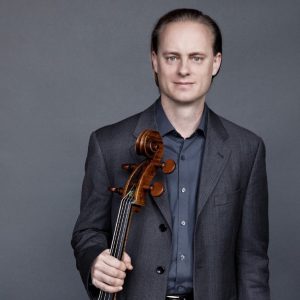“You can teach how to play the cello, but you can’t teach musicality!”
I can’t tell you how many times I have heard this old chestnut espoused, both by teachers and by students. For many years, I believed it. But is it really true? Let’s start by asking the unasked question: what is musicality? Can we even agree on which performances are musical as opposed to “technical?”
After years of performing, teaching, and carefully observing both my own playing and that of others, I’ve noticed a curious phenomenon: everybody sucks at answering this question.
Many times I have been upset at myself for playing a wooden performance, and then upon hearing a recording of that performance, was moved by what I heard. Many more times, the opposite was true. Very occasionally, my perception of the performance matched what I heard. Sometimes, the perception of the same recording of our own performance by 2 members of the Chiara Quartet, listening in the same room at the same time from the same speakers varies so widely it’s astonishing. And we work together all the time!
So let’s first abandon the idea that there is any objective way of describing when a specific performance is “musical” and see if we can’t find common ground that defines what artistry is. Otherwise, the old canard is correct. If you can’t define artistry, there is no way to practice or improve it.
Some would define artistry as the ability to integrate information about compositional structure, historical style, historical context, or performance traditions into a specific piece. All of these things are important, but I would argue not sufficient to create a musical performance. Most often, in my experience, context is used to set up rigid rules that interfere with the music-making process. If context doesn’t inspire you, it will not be effective at inspiring your audience. Let me stress that I am a huge fan of all the contextual things you can find to enhance a performance, and understanding how context bends interpretation is crucial to a deep musical understanding of a work. It just isn’t enough to create musicality on its own.
All right, I’m going to try to define artistry in the context of music based on my experience:
Musicality is the process by which deep associative emotions and memories bend the specific technical aspects of a musical performance.
For some people, this kind of artistry comes naturally, without effort. For everyone else, there are two aspects of the manifestation of musicality that must be present. The first is a strong connection between the mental image of playing and the physical way our body creates those motions. The second is an ability to connect our own associative experiences and associative emotions to sounds that evoke them.
That’s a lot of big words, let’s see if I can simplify!
If you think back to a moment in your life that you were very happy, what do you notice first? Was it an image, perhaps of a family gathering or a triumphant moment? Was it the feeling of the room? The scent of a loved food? The sensation of touch of a loved one? The sound of the time? These experiences are associative memories. I did not ask you to think of that specific event, but by thinking of the emotion “very happy,” you associate that emotion with a specific memory.
When you are performing a favorite part of a piece of music, emotional and/or memory associations are triggered by the sound, or the feeling of playing or some combination of the two. Musicality is the same process in reverse: an emotion is used to trigger specific sounds or physical techniques that then evoke/reinforce that emotion or memory for you.
For some, it is a struggle to think of a specific memory that evokes an emotion. Science shows us that associative memories are strengthened the stronger the emotion is, as this study shows us.
How do we use this information in music? In my experience, the faster you can create a strong association between a thing you are trying to play and some kind of mental image, the more likely you are to execute that thing with musical content. Through the magic of mirror neurons, when you feel something strongly, your audience will sense that as well.
Practicing musicality is an iterative process. First, you need to choose a passage you’d like to play. Then, while playing it, notice what associations are triggered in your mind or heart. Next, try to find a stronger mental image that is the same or rhymes with the one the music naturally triggered. Play again, this time actively imagining the image you chose, and notice how the technique of playing has changed. Repeat.
The same process can and should be used to take external contextual information about a piece and integrate that into the performance. For instance, reading a text about historical performance practice, you might discover that Leopold Mozart recommends appoggiaturas be performed almost twice as long as the rhythmic value that is notated. In order for this effect to work, you would first play it, and listen not just to the sound, but to the associations it creates when you execute the appoggiatura. Next, take the weak associations that you have noticed, and imagine a stronger, more positive association, one that enhances the effect so that you like it more. Perform the appoggiatura again, letting the new association bend the performance, and listen carefully: did the association make you like the effect more? Repeat.
All of this is to say that everything ultimately returns to a Harry Potter analogy. Want to improve your musicality? Practice your patronus charms!
One important aspect of this moment in the Harry Potter story is that Harry is not able to figure this out on his own, but needs the help of a master teacher to guide him. You are probably not better than Harry Potter. Reach out to a teacher or a colleague who understands how to unlock this potential.
 From the beginning of his work as a performer, cellist Gregory Beaver has been fascinated with the process of growth. This fuels his performing, teaching, and writing with a passion from 17 years of performing internationally with the Chiara String Quartet. It permeates his published writings in Strad Magazine, a book on computer programming, his contributions to the open source programming world and even his personal recipe for guacamole. After the Chiara Quartet concludes its performing activities in 2018, Mr. Beaver will take this passion and devote it to expanding his teaching activities.
From the beginning of his work as a performer, cellist Gregory Beaver has been fascinated with the process of growth. This fuels his performing, teaching, and writing with a passion from 17 years of performing internationally with the Chiara String Quartet. It permeates his published writings in Strad Magazine, a book on computer programming, his contributions to the open source programming world and even his personal recipe for guacamole. After the Chiara Quartet concludes its performing activities in 2018, Mr. Beaver will take this passion and devote it to expanding his teaching activities.
Teaching traditionally invokes the image of a staid classroom, clear curriculum and strict rules to be followed. Mr. Beaver is not interested in just conforming to what has been tried in the past. His experience in the bumpy career path of a professional string quartet illustrated quite clearly that a holistic understanding of life, art, and business is more energizing. His students have been on the receiving end of experiments for many years to help them develop the precise skills needed to unlock their true potential, as humans and ambassadors for their music, and not just as cellists. He is the author of several cello etudes called the “Impossible Etudes” and myriad exercises to fine-tune the specific needs of each student.
His writing touches on issues relating to self-awareness, on practicing effectiveness, on connecting to others more effectively in chamber music as well as poetry and larger issues with society and politics. Mr. Beaver writes for his blog, https://gregorybeaver.com, as well as CelloBello, where he is a regular guest on “cello chats.”
Before his professional life in the Chiara Quartet, Mr. Beaver studied with Joel Krosnick at the Juilliard School, and Norman Fischer at Rice University. He had the opportunity to work with great conductors such as Claudio Abbado, Pierre Boulez, Seiji Ozawa, played principal cello of the Tanglewood Music Center Orchestra, and won first prize at the Corpus Christi International Competition. He began his cello studies under Char Sherman as a Suzuki student and studied in high school with renowned pedagogue Louis Potter, jr. Mr. Potter studied with Willem Willeke at Juilliard, graduating in 1935. Mr. Willeke had a long and fruitful relationship with Johannes Brahms, perhaps explaining why Mr. Beaver feels an affinity for Brahms. Gregory loves to experience the completeness of things, and has performed cycles of Solo Bach, Beethoven Cello/Piano Sonatas, as well as Brahms, Beethoven, and Bartok cycles with the Chiara Quartet. He lives with his wife, Hyeyung Yoon, 2 daughters and cat in Lincoln, Nebraska.






